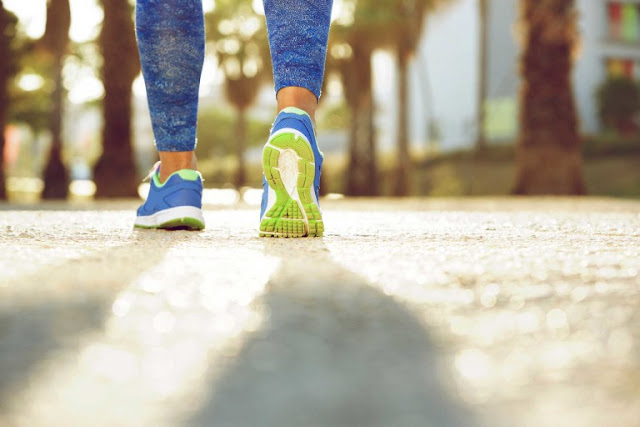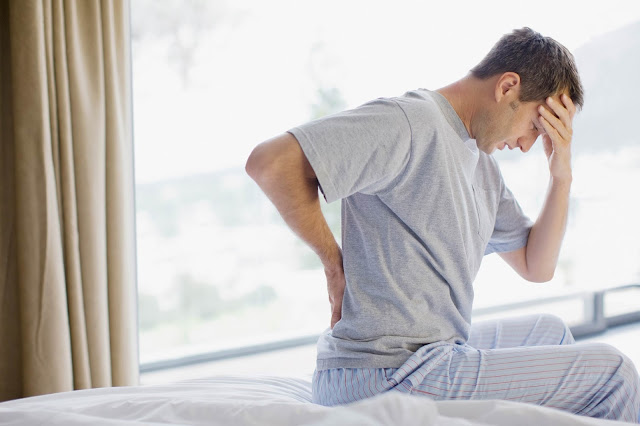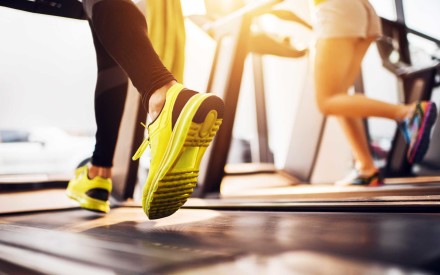Can’t Take 10,000 Steps a Day? Do This Instead
For days when it's not feasible to cram in the recommended 10,000 daily steps, this shorter routine has got you covered.

Taking 10,000 steps per day is a great way to get your daily dose of physical activity, but only 15 percent of American men and women regularly hit that healthy target, according to a brand-new study from Oregon State University. Lack of time is the most commonly cited obstacle, but fortunately, there’s an alternative that may be easier to fit into a tight schedule.
In the year-long study, published in the journal Medicine & Science in Sports & Exercise, Oregon State researchers found that although people who took more steps each day were typically healthier than those who took fewer steps, speed made a difference. Those who took 5,000 to 7,000 steps at a faster pace scored similar health benefits, including things like smaller waist circumference, lower blood pressure, and reduced BMI and cholesterol levels.
Based on these findings, study co-author John Schuna, Jr., PhD, assistant professor of kinesiology at OSU’s College of Public Health and Human Sciences, recommends aiming to take 3,000 steps each day at a brisk pace, which may be 100 or more steps per minute for two and a half hours, or 150 minutes, each week.
This healthy target fits with the guidelines of both the CDC and the Department of Health and Human Services, which advise that healthy adults get at least 150 minutes of moderate intensity activity or 75 minutes of vigorous aerobic activity each week. Examples of moderate intensity workouts include brisk walking, yoga, pushing a lawn mower, gardening, or riding a bike under 10 mph; examples of vigorous intensity activity include jumping rope, running, jogging, biking over 10 mph, and hiking uphill.
“Running or jogging two and a half miles is equivalent to walking 10,000 steps,” says Chauncey Graham, CSCS, an ACE Fitness Professional at Gold’s Gym in Washington, D.C. Higher-intensity workouts also come with added benefits, including improvements to your cardiorespiratory system. “A heightened level of exercise will prevent and lower your risk of many common diseases as well as obesity,” Graham says.
Most experts agree that a mix of high intensity and moderate intensity workouts yield the best results, however, if you’re dedicated to reaching your 10,000 steps each day via walking, try to take 3,000 of those steps at a faster pace. But some exercise is certainly better than none, so if you can spare only 60 seconds to sweat, try these exercises that will transform your body.
 Conditions
Diet & Weight Loss
Diet and Weight Loss
Everyday Wellness
Fitness
Health
Health Care
Healthy Eating
Conditions
Diet & Weight Loss
Diet and Weight Loss
Everyday Wellness
Fitness
Health
Health Care
Healthy Eating
7 Clear Signs You Need to Move More
Yes, exercise can help you lose weight, but you’ll be surprised at how many other ways it can radically improve your health and well-being.
You're suddenly experiencing pain
We’ve all had one of those mornings—you wake up and your lower back, knee, or shoulder is suddenly aching. But while you might be tempted to wait it out, certified personal trainers Jim Karas and Michelle Blakely suggest getting your body in motion. Just moving your muscles, loosening your joints, and getting blood pumping to that area of your body can be enough to lessen the pain, Karas says. Even clients who have faced longer-term pain, like that which comes with rheumatoid arthritis, have improved their daily movement and ability to do chores by getting regular exercise. After your workout, chow down on one of these foods that fight pain naturally.
You're constantly fatigued
If you’re tired all the time, even with adequate food and sleep, maybe all you need is to move a bit more. It may seem a bit counterintuitive, but a study from the University of Georgia showed that just 20 minutes of moderate-intensity aerobic exercise three times a week increased energy levels by 20 percent. Researchers said the findings showed how exercise directly acts on the central nervous system to decrease fatigue, in some cases as much as 65 percent, according to the New York Times. “I like to tell my clients that an object in motion stays in motion,” says Chicago-based personal trainer Traci Mitchell. “It’s kind of like getting that big boulder of motivation moving, and once it gets moving, your energy increases.” Here are more tricks to beat fatigue naturally.
You're stressed
“Stress levels have never been higher,” Karas says, and statistically, he is right. Researchers at Carnegie Mellon University showed that stress increased 18 percent for women and 24 percent for men from 1983 to 2009. We’re more worried about finances, constantly bombarded by media and information, and too busy to decompress—and that stress could be making us sick. But just walking, running, or strengthening your body for 20 to 30 minutes three to four times a week is enough to significantly decrease your anxiety, and research shows that adding in music makes that exercise even more effective in fighting stress. “If you’re dealing with a difficult decision, probably one of the best things you can do, whether it’s personal or business, is to get out and put your ear buds on,” Karas says.
Your hormones could use some TLC
Exercise is an excellent way to help regulate your hormones, and you’d be surprised at how much that can impact how you think, look, and feel. For example, boosting your testosterone levels, which can be done through exercise, helps increase your metabolism, maintains youthful-looking skin, and keeps your brain functioning properly, according to Karas.
Your digestion is out of whack
A 30-minute run or brisk walk will do more than just increase your appetite for dinner; it will help you digest your dinner, too. Aerobic exercise quickens your breathing and heart rate, which in turn improves the contraction of your intestinal muscles. As a result, your digested food passes more quickly through your intestines and out of your body, decreasing constipation. Moving in whatever method (walking, running, swimming, dancing, and even stretching or yoga) will help with digestion. Enhance the healthy belly benefits your workout by adding foods that boost good gut bacteria to your diet.
Your time-management tricks are failing you
Personal trainer April Sutton says a lot of her clients approach her for assistance when they feel like they’ve lost control over how they structure their time due to overwhelming work and family commitments. “They can’t really think for themselves outside of their jobs because they’re so burnt out,” says Sutton. Trainer Michael Moody has clients prioritize exercise, and think about how other habits (how they eat, sleep, and how much they sit at work) can impact how they feel when they exercise. Becoming “human scientists of their body” helps people better understand how their lifestyles can impact their health, Moody says. From there, it’s a matter of correcting bad habits, and continuing to put aside time to exercise regularly. Besides exercise, successful people do these things after work.
You're not sleeping well
If you’re having trouble nodding off or staying asleep at night, you may need to move a bit more during the day. In a study published in the journal Sleep Medicine, researchers at Northwestern University found that insomniac middle-aged and older participants who exercised and were taught to sleep in a cool, dark room and go to bed at the same time each night got 1.25 more hours of sleep nightly than those who did not participate in physical activity. Whether you have chronic insomnia or you just haven’t been sleeping well lately, getting some aerobic activity in during the day will probably help you catch more Z’s at night. Here are some signs you're not sleeping deeply enough.
Eucalyptus Oil: How It Heals
You can use eucalyptus oil to treat everything from bad breath and body odor to bronchitis and colds and flu.
Australian Aborigines traditionally used infusions of eucalyptus leaves to relieve respiratory congestion, coughs, and fevers, and as topical applications for sore muscles. Essential oil was distilled from eucalyptus trees not long after the first European settlers arrived in Australia. Commercial production commenced in the mid-1800s, and the oil soon came to be highly prized around the world for its antiseptic and antibacterial properties.
How Eucalyptus Oil Works
Eucalyptus oil contains several active constituents. The most important is 1,8-cineole (sometimes referred to as eucalyptol), which has an antimicrobial effect against a wide range of disease-causing bacteria, viruses, and fungi.
How to Use Eucalyptus Oil
For respiratory conditions such as asthma, sinusitis, bronchitis, colds and flu, eucalyptus oil is often used as an inhalation—commonly via a nebulizer or vaporizer in which the oil is diluted in steaming water. It is sometimes also used in a cream or ointment that is rubbed onto the chest, delivering the therapeutic actions through a combination of inhalation and the penetration of the oil through the skin. It is also sometimes included in throat lozenges or cough mixtures in minute quantities.
Topical applications of eucalyptus essential oil (usually in dilute concentrations) can also be used to treat infections of various kinds. For example, the essential oil and/or 1,8-cineole derived from it are often included in mouthwash products to help kill the bacteria that cause plaque, gingivitis, and bad breath. Eucalyptus oil can also be added to laundry to kill dust mites in sheets, disinfect clothes and leave the washing smelling fresh.
Research also suggests that an ointment containing eucalyptus oil and other antimicrobial substances may be beneficial in the treatment of fungal toenail infections.
Safety First
Eucalyptus oil should not be taken internally. The topical use of the oil is not suitable for babies, children, pregnant or breastfeeding women, or people allergic to Eucalyptus spp. Caution is advised with eucalyptus inhalations as they can irritate the eyes, mucous membranes and skin.
Where to Find Eucalyptus Oil
Eucalyptus essential oil is available in health food stores and pharmacies or from a qualified aromatherapist.
Benefits of Ginger: How It Heals Indigestion and More
Think beyond ginger ale.
This tasty spice has been used as both a condiment and a medicine for centuries. It was a staple at Roman banquets, to counter symptoms of overindulgence, and was much favored in ancient China and in India’s Ayurvedic medicine as a remedy for indigestion, stomachaches, respiratory congestion, constipation, and diarrhea. It was also used as a tonic for women’s gynecological conditions, being thought to stimulate the flow of qi, or energy, to the reproductive organs.
How Ginger Works:
Ginger contains antioxidant substances called gingerols, which are thought to be responsible for its ability to alleviate nausea and indigestion. Unlike many conventional antinausea medications, ginger has the important benefit of not causing undesirable side effects such as a dry mouth or sleepiness. Research has shown that ginger can address nausea caused by a variety of causes, including food poisoning, motion sickness, pregnancy, postsurgical procedures, or the side effects of conventional drug treatment, notably chemotherapy. Similarly, ginger has been shown to alleviate symptoms of indigestion, including flatulence, bloating, and griping pain.The gingerols in ginger are also thought to account for its ability to alleviate some of the symptoms of rheumatoid arthritis, osteoarthritis, and muscular discomfort such as pain, inflammation, and swelling, possibly by inhibiting the production of inflammatory substances called prostaglandins and leukotrienes. This may also account for its ability to naturally relieve menstrual cramping.
Ginger is often given as a tonic to fight colds and chills and improve circulation, with Taiwanese research confirming its benefits for circulatory health, as it does have mild blood-thinning properties. Ginger also has antimicrobial, carminative, and diaphoretic (increases sweating) properties and may help to boost the immune system. These qualities make it of some benefit in treating coughs, colds, laryngitis, or a sore throat where it is often combined with honey and lemon.
How to Use Ginger:
Ginger can be eaten fresh or dried, or in pickled, jellied (candied), crystallized or syrup form, as a tea, or taken as a supplement, either as a tablet or capsule. When using supplements, follow label instructions or take as professionally prescribed.Safety First:
Consult your doctor if using high doses of ginger while taking anticoagulant (blood-thinning) medications.Where to Find Ginger:
Ginger supplements and tinctures are available in health food stores. Fresh ginger is sold in supermarkets.Morning Habits of Naturally Thin People
Rise and shine! Incorporating these simple steps into your morning routine may make it easier to lose weight.
They open the shades

A flood of sunshine isn’t just an instant morning pick-me-up: A Northwestern University found that people exposed to moderately bright light in the morning have significantly lower BMIs than people who get the majority of their light exposure later in the day. Independent of physical activity, sleep timing, caloric intake, age, or season, morning light exposure accounted for about 20 percent of an individual’s BMI. Lack of sunlight can de-synchronize your internal body clock, altering metabolism and leading to weight gain. Just 20 to 30 minutes of morning light is enough to affect BMI.
They butter the bottom of toast

It sounds strange, but if you’re looking to lower calorie intake, look to the bottom side of your breakfast foods. “Butter the bottom of toast, and salt the bottom of potato rounds,” Devin Alexander, chef and host of FitTV’s Healthy Decadence, told Health. “It really helps with weight loss. When you eat foods this way, the flavor hits your tongue right away, and you actually taste more of it. Ultimately that means you can cut out at least half the belly-bloating salt or butter.”
They pick the right glassware

When you pour your OJ or apple juice, use a tall, thin glass to save on sugar and calories. A Cornell University study found that when participants poured into a short, squat glass, they drank 25 to 30 percent more. Researchers say individuals tend to focus on the height of the liquid they pour (rather than the width) and therefore estimate tall glasses hold more liquid than wide ones of the same volume.
They include protein in breakfast

Most Americans only get about 10 to 15 grams of protein for breakfast, but doubling that may help you lose weight. Research presented at an Obesity Society meeting found that women who ate a breakfast with 30 grams of protein from sausage and eggs consumed about 100 fewer calories at lunch compared to those who ate a low-protein pancake breakfast. “Protein is key for satiety,” Heather Leidy, assistant professor in the Department of Nutrition and Exercise Physiology at the University of Missouri, told Eating Well. “It activates the body’s signals that curb appetite, reduce food cravings, and prevent overeating.”
They take a few minutes to meditate

No need to chant in lotus position. Just focusing on your breath for a few minutes in the morning could help increase your mindfulness, leading to a day of smart food choices. Brown University researchers distributed a 15-question survey to nearly 400 people and measured their body composition. The survey included questions such as “I find it difficult to stay focused on what’s happening in the present.” People who showed low levels of mindfulness on the Mindful Attention Awareness Scale (MAAS) were 34 percent likelier to be obese and held a pound more of fat in their bellies. Researchers say individuals who are more aware of their thoughts may be likelier to notice the negative emotions caused by eating too much.











